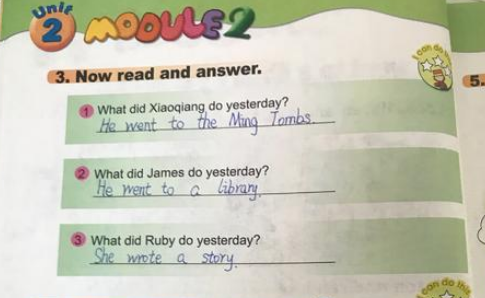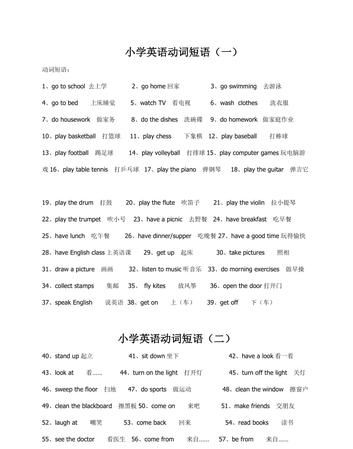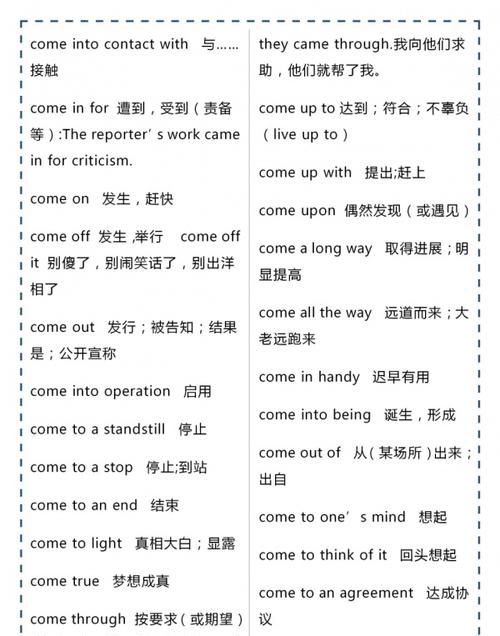本文目录
1~6年级英语重点句型及语法
如下:
1、询问他人哪些时候做某事的句式及答复。
句式结构:
问:When do you+动词短语原形+其它?(你/你们哪些时候做某事?)
答:I/we(+频度副词)+动词短语原形+at+具体时间 (我/我们一般在几点做某事。)
注意:在主语是第三人称单数(he、she、it单个人名或者单数专有名词)时,助动词do要变为does,句式结构是:when does+主语(第三人称单数)+动词短语原形+其它?
2、询问他人礼拜天干什么的句式及答复。
句式结构:
问:What do you do on the weekend?(你礼拜天干什么?)
答:I(+频度副词)+动词(短语)+其它。
3、比喻气候的形容词。
hot 酷热的;warm 暖和的;rainy多雨的;windy 多风的;foggy有雾的;cold 严寒的;cool凉快的;sunny明朗的;cloudy 多云的;snowy下雪的。

4、由go组成的活动短语。
go swimming去游水;go shopping去买东西;go boating去荡舟;go skating去滑雪;go hiking去郊游;go fishing去垂钓。
5、寻问他人气候怎样的句式及答复。
句式结构:
问:What’s the weather like+时间+地址?
答:It’s+表明气候的形容词。
6、询问他人最爱的时节句式及答复。
句式结构:
问:which season do you like best? (你最爱的时节是哪个?)
答:I like+时节+best或者直接说时节称呼。
3到6年级英语词组科普版
wash
your
hands
洗手
blow
your
nose
擤鼻子 brush
your
hair
梳头发
clean
your
ears
清洁耳朵 touch
your
toes
触摸脚趾
raise
your
arms
举起手臂 close
your
mouth
闭起嘴巴
left
arm
左手臂 right
leg
右腿
on
the
bed
在床上面 in
the
pencil-case
在铅笔盒里面
open
your
book
打开书本 pack
your
bag
收拾书包
here
you
are
给你 a
picture
of
一幅......的画
over
there
在那边 in
English
用英语说
the
sun
太阳 how
many
多少
there
are
有 sit
down
坐下
turn
to
page
翻页

3到6年级英语动词词组
1. 以break为中心的词组
break away from 脱离,逃离
break down 破坏,粉碎;瓦解;出故障,抛锚
break in 闯进,打断;使顺服
break into 闯入;强行进入;突然开始
break out 爆发,发生;准备使用;起锚
break the law 违反法律
break the record 破记录
break one’s promise 失言
break up 开垦,破碎;解散,分开,分解
2. 以catch为中心的词组
be caught doing 被发现做某事
be caught in the rain 淋雨
catch a bus/train 赶汽车/火车
catch a cold 伤风,感冒
catch one’s word 听懂某人的话
catch sight of 发现,瞥见
catch up with 赶上,追及,追上
3. 以come为中心的词组
come across 偶尔发现,想起;越过;偿付
come along 一道来,陪伴;进步,进展;出现
come at 达到,求得,得到;扑向,袭击
come back 回来;恢复,复原
come down 倒下;降落;跌落;病倒
come from 来自,起源于,从~~产生,生于
come in 进来,进入;流行起来;获名次
come into being 发生,产生,出现,形成
come into power 开始执政,当权,当选
come into use 开始使用,获得应用
come on 上演;开始;赶快;发展;登台;(问题)被提出
come out 出来,传出;出版;结果是;褪色;(秘密)泄露
come to 苏醒,复原;共计;达到;归结于
come to an end 终止,结束
come to know 开始了解到
come true 实现,成为现实;证实
come up 走近;上楼;长出,发芽
4. 以do为中心的词组
be done in 精疲力竭
be done with 完全结束
do a good deed 做一件好事
do away with 去掉,废除;弄死;浪费
do good to (=do sb. good) 有益于
do harm to (=do sb. good) 有害于
do its work 有效,有作用
do much 极有用
do wrong to 做错
do one’s best 尽某人最大努力
do one’s homework 做作业
do one’s utmost 尽力而为
do proud 足以使~~骄傲
do sb. justice 公平对待某人
do some cleaning (V+ing,etc.) 搞卫生
do sb. a favor 帮助某人
do well in 学得不错,干得漂亮
do with 和~~相处,忍受,处理
do without 不需要,不用
do wonders 创造奇迹
have much to do with 和~~很有关系
have nothing to do with 与~~无关
have something to do with 和~~有关
in doing so=in so doing 这时,在这种情况下
That will do. 行了;够了
5. 以get为中心的词组
get about 徘徊,走动,旅行;流传
get above oneself 自视高傲
get accustomed to 习惯于,对~~习以为常
get across 度过,通过,横过;说服,使理解
get ahead of 胜过,超过
get along 前进,进步;同意;离去
get along with 与~~相处
get at 发现,了解;掌握;攻击
get away 离开,逃脱
get back 取回,回来;报复
get behind 落后;识破
get down 咽下;写下;使沮丧,使抑郁
get down to 认真对待,静下心来
get familiar with 熟悉
get hold of 获得,取得
get home 到家
get in 进入,陷入;牵涉
get off 送走;脱下(衣服);下车;动身
get on 上车;穿上;进步,使前进;成功;相处
get upon with 进步;在~~方面获得成功
get one’s hand in 熟悉;习惯
get out of 由~~出来,从~~得出;避免;退休
get over 越过;恢复,痊愈;克服;完成
get ready for 为~~作准备
get rid of 除去,去掉;免除,摆脱
get through 到达,完成,通过;及格
get together 积聚,积累;商谈,取得一致意见
get up 起床,起立;研究,钻研;致力于;安排,组织
get used to 习惯于
have got to do 不得不,必须
6. 以give为中心的词组
be given to 沉溺于,癖好
give about 分配;传播
give and take 相互迁就
give away 赠送;牺牲;泄露;颁发
give back 归还
give cause 给予~~的理由
give ear to 侧耳倾听
give forth 发出,放出;发表
give in 屈服,让步,投降
give in to 同意,接受;向~~让步
give off 发出(烟,气味)
give oneself out to be/as 自称为
give oneself up to 专心于;向~~自首
give out 分发,公布
give place to 让位于,被~~所替代
give rise to 引起,导致;使~~发生
give sb. to understand 通知某人
give up 放弃;停止
give way to 让步,退却;屈服于
7. 以look为中心的词组
look about 四下环顾;查看
look after 照顾,看管
look around 东张西望
look at 注视,着眼于
look back 回顾
look for 寻找;期待,期望
look down on 俯视;轻视
look forward to 盼望,期待
look into 窥视;调查;浏览
look like 看起来象
look on 旁观;面向
look out 向外看;注意;当心,堤防
look over 从上面看过去;检查
look through 透过~~看去;看穿;浏览
look up to 仰望,尊敬
8. 以make为中心的词组
be made from 由~~原料制成
be made of 由~~材料制成
be made up of 由~~组成
make a fool of 愚弄,欺骗
make a mistake 弄错
make a point of doing 强调;认为~~重要;决心,坚持
make advantages/use of 使用,利用
make after 追求,追赶
make believe 假装
make certain 确信,把~~弄清楚
make contact with 接通,与~~接触,与~~联系
make for 去向,向~~前进;有利于
make friends with 和~~交友
make into 把~~制成,使~~转变为
make much of 重视;理解;赏识
make one’s mind on sth. 决定某事
make one’s own 当作自己的看待
make oneself at home 随便,别拘束
make out 填写;开支票;理解;辨认
make the best of 尽量利用;极为重视
make up 弥补,修理;赔偿,补偿;起草;编造;化装
make up to 接近,巴结;向~~求爱
make way for 为~~让路,让路于
on the make 急求成功;增加
9. 以put为中心的词组
put aside 把~~放在一边;搁置;排除
put away 把~~放好,把~~收拾;储藏;吃喝,吃掉
put back 把~~放回原处;驳回
put down 放下;镇压;制止;记下;削减;降落
put forward 提出;拨快;建议,推荐;提倡,倡议
put ~~ into 把~~放入;插入;翻译成
put off 推迟,延期;消除;推脱,推辞
put on 上演;穿上,带上
put one’s heart into 全神贯注,专心致志
put up 举起,挂起;提名,推荐;陈列
put up with 忍受,容忍
10. 以take为中心的词组
be taken aback 吃惊
take a seat 就坐
take a shower 淋浴,洗澡
take aim 瞄准,设立目标
take away 拿走,减去;夺去
take ~~ by surprise 出奇制胜
take care of 当心,注意;照顾;提防;谨慎;处理,对付;负责
take ~~ for 把~~当作
take off 脱去,除去;离开;起飞;模仿;起程;致死;复制,作副本;减弱
take office 就职,上任
take one’s place 就坐,入坐
take one’s temperature 量体温
take part in 参与,参加
take place = happen 发生,举行
take the place of 代替
take pride in 以~~为荣,对~~骄傲
take sb. by the arm 拉某人的胳膊
take it easy 别着急,慢慢来
11. 以turn为中心的词组
give a new turn to 对~~予以新的看法
in one’s turn 轮到某人做某事
out of turn 不按次序的,不合适宜的
take one’s turn to do 轮到做
turn a blind eye to 对~~视而不见
turn against 背叛,采取敌对态度
turn back 折回,往回走
turn down 折叠,翻下,驳回,拒绝考虑
turn into 走进;变成,变为
turn to ~~for help 求助于
turn off 关上(自来水,电器开关);解雇,辞退;避开(问题);制造;生产
turn on 打开(自来水,电器开关);反对;依靠,依赖,取决于
turn one’s attention to 把注意力转向
turn out 培养;证明是;制成;实际情况是
turn out to be 原来是,证明是,结果是
turn over a new leaf 翻开新的一页,重新开始,改过自新
turn (a)round 旋转,转过身来;改变意见;采取新政策
turn to 变成;着手于
turn upside down 颠倒过来,翻过来;使陷入混乱

六年级上册英语动词有哪些
一至六年级的英语动词有be动词、情态动词、助动词、行为动词。
一、be动词(am,is,are,was,were )
1、amwas,is was,are--were口诀:我用am,你用are,is用在他她它,所有复数全用are。
2、肯定和否定句I am (not) from London. He is(not) a teacher. She is(not) in the dining room. My hair is(not) long. Her eyes are(not) small.
3、一般疑问句Am I a Chinese? Yes,you are. No,you arent. Are they American? Yes,they are. No,they arent. Is the cat fat? Yes,it is. No,it isnt.
4、be动词的否定形式:am not(没有缩写形式),are not = arent,is not = isnt.

二、助动词(do,does,did )
do,does用于一般现在时,其过去式did用于一般过去时。它们通常用在疑问句和否定句中。它们的否定形式:do not = dont,does not = doesnt,did not = didnt.
注意:在一般现在时中,does用于第三人称单数,其余一律用助动词do;助动词do,does,did后面一定要用动词原形。
三、情态动词
情态动词也是一类特殊的动词,平时我们不把它说成是动词。情态动词可以和行为动词同时出现在同一个句子中。我们现在学过的情态动词有:can、could、shall、should、will、would、may、might、must.注意:情态动词后动词总是用原形。(不受其他任何条件影响)
四、行为动词
就是平时上课时说的动词,表示某一动作或行为。如:sweep、live等。行为动词我们已学过它们的四种形式:原形、第三人称单数+s/es、现在分词(也叫动名词)+ing、过去式+ed。
动词第三人称单数变化规则:
A、一般直接加s,如:play plays,visit visits,speak speaks.
B、以s,x,sh,ch结尾时,加es,如:catch catches,watch watches.
C、以辅音字母+y结尾时,变y为i再加es,如:carry carries,study studies.
以上就是关于3~6年级英语动词短语 ,1~6年级英语重点句型及语法的全部内容,以及3~6年级英语动词短语 的相关内容,希望能够帮到您。

